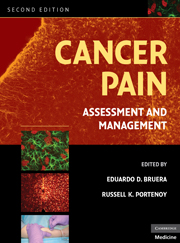Book contents
- Frontmatter
- Contents
- Contributors
- Preface
- SECTION I MECHANISMS AND EPIDEMIOLOGY
- SECTION II EPIDEMIOLOGY AND SYNDROMES
- SECTION III ASSESSMENT
- SECTION IV PHARMACOLOGICAL TREATMENT
- SECTION V OTHER INTERVENTIONAL STRATEGIES
- SECTION VI REHABILITATION AND PSYCHOLOGICAL INTERVENTIONS
- SECTION VII THE ROLE OF ANTINEOPLASTIC THERAPIES IN PAIN CONTROL
- SECTION VIII PAIN IN SPECIAL POPULATIONS
- 22 Cancer pain management in the chemically dependent patient
- 23 Cancer pain in children
- 24 Managing cancer pain in the elderly
- SECTION IX DIFFICULT PAIN PROBLEMS
- SECTION X SYSTEMS OF CARE
- Index
- Plate section
- References
23 - Cancer pain in children
from SECTION VIII - PAIN IN SPECIAL POPULATIONS
Published online by Cambridge University Press: 06 July 2010
- Frontmatter
- Contents
- Contributors
- Preface
- SECTION I MECHANISMS AND EPIDEMIOLOGY
- SECTION II EPIDEMIOLOGY AND SYNDROMES
- SECTION III ASSESSMENT
- SECTION IV PHARMACOLOGICAL TREATMENT
- SECTION V OTHER INTERVENTIONAL STRATEGIES
- SECTION VI REHABILITATION AND PSYCHOLOGICAL INTERVENTIONS
- SECTION VII THE ROLE OF ANTINEOPLASTIC THERAPIES IN PAIN CONTROL
- SECTION VIII PAIN IN SPECIAL POPULATIONS
- 22 Cancer pain management in the chemically dependent patient
- 23 Cancer pain in children
- 24 Managing cancer pain in the elderly
- SECTION IX DIFFICULT PAIN PROBLEMS
- SECTION X SYSTEMS OF CARE
- Index
- Plate section
- References
Summary
Introduction
Palliative medicine has been slower to develop in the pediatric world than in the adult one. This may partly be simply because fewer children die: The death of a child, even in a busy pediatric oncology department, is a relatively rare event compared with an adult unit.
It may also be because most pediatric specialties already have at their heart an approach that is holistic or multidimensional and patient centered. Although it is often more honored in the breach than the observance, this principle means that palliative care has perhaps had to recapture a vision in adult medicine that pediatrics has never quite lost.
Most of those practicing palliative medicine among children today are pediatricians. For any specialty involving close clinical contact with children, adequate training and experience in pediatrics is a sine qua non. Faced with a child in pain, a key question is often thought to be, How is pain in children different from that in adults? The more important question is, perhaps, How does the child in pain differ from other children? The child in pain is a child first: A thorough understanding of children is a prerequisite to understanding their pain.
But we are still in the vanguard of the development of pediatric palliative care. It will be some years before specialist pediatricians can provide all tertiary palliative medicine necessary for children. In the meantime, pediatricians should be willing to work alongside their adult colleagues in the care of children with life-limiting conditions.
- Type
- Chapter
- Information
- Cancer PainAssessment and Management, pp. 433 - 443Publisher: Cambridge University PressPrint publication year: 2009

